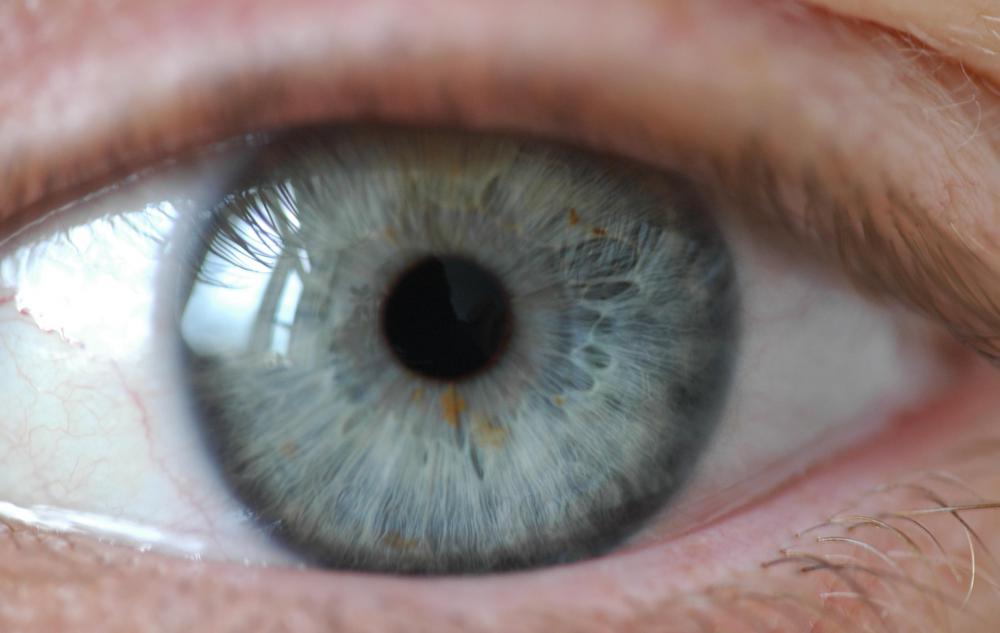At TheHealthBoard, we're committed to delivering accurate, trustworthy information. Our expert-authored content is rigorously fact-checked and sourced from credible authorities. Discover how we uphold the highest standards in providing you with reliable knowledge.
What is a Photoreceptor?
Photoreceptors are nerve cells which have been designed to be sensitive to light. These cells are located in the eye, allowing an organism to see, and the process through which they work is complex and quite fascinating. There are three types of photoreceptors: rods, cones, and photosensitive ganglion cells, and each plays a distinct role in vision.
When a photoreceptor is exposed to light, photosensitive proteins in the neuron are stimulated, triggering a series of responses which convert the light into a signal which can be read by the brain. This process happens in a fraction of a second, allowing a photoreceptor to provide constant information to the brain about the visual environment. Certain photoreceptors are sensitized to particular spectra, and the brain uses information from these cells to distinguish colors. Rather than literally seeing color, in other words, the photoreceptor responds to specific spectra, and the brain averages responses to determine what the eye is seeing.

Photoreceptor cells which have been sensitized to specific spectra are known as cones, the cells which famously allow people to “see” color. These cells have a cone-like shape when viewed under magnification, explaining the name, and they require bright light to function effectively. Rods, on the other hand, work in very low light, but do not distinguish color well. Many organisms have a mixture of rods and cones which is designed to strike a balance between being able to see well in the dark, and being able to distinguish colors.

The third type of photoreceptor, photosensitive ganglion cells, appear to play a role in circadian rhythms, and they can control pupil size as well by providing the brain with information about how much light is available. Along with rods and cones, the photosensitive ganglion cells are found in the retina of the eye. These cells were discovered in the 1990s, long after the presence of rods and cones had been established. Researchers have studied these cells by examining subjects with blocked inputs from rods and cones.

In order for photoreceptors to work properly, they need a steady supply of the proteins they use to detect light. One of these proteins is famously synthesized from vitamin A, which is why people are encouraged to include lots of this vitamin in their diets. Nutritional deficiencies can lead to a declined production of these proteins, causing vision problems. Some examples of proteins found in photoreceptors include: melanopsin, opsin, and retinal.
AS FEATURED ON:
AS FEATURED ON:













Discussion Comments
@JimmyT - I remember reading about how night vision worked a few months ago. It has something to do with eye photoreceptors, but there is much, much more to it. I don't remember what all was involved, but I remember it is complicated.
I was wondering if there are any diseases or malfunctions of the photoreceptors. The article mentions Vitamin A being important. What happens if you don't get enough of it? Do you start losing your vision? Besides that, are there birth problems people can have where they don't have the normal numbers of rods and cones? Would it just be blindness, or are there intermediate problems?
Besides photoreceptors in the eye, when I was taking my botany class in college, I know we talked about photoreceptors being part of how a cell collects sunlight for photosynthesis. I don't remember all of the exact steps anymore, but I know there are special cells in the leaves that pick up different wavelengths of light and use solar energy to make sugars in the plant.
Back to people again, how are photorecpetors linked to night vision, if at all? I know the key to night vision is for the eye to be able to pick up as much light as possible, but I didn't know if rods and cones played into this at all.
@cardsfan27 - Actually, dogs being able to only see in black and white isn't really true. I'm not sure when people started to say that, but it has spread to where it is assumed to be a fact.
Actually, a dog's eyes contain photoreceptors of rods and cones just like our eyes. The difference is that they don't have as many cones. Instead of seeing the same colors we do, scientists think dogs see the same types of things as someone who is colorblind, so dogs have a hard time telling between different shades of green and red.
I'm not sure if they actually have more rods, but the size of a dog's eyes and other characteristics are what let them see better at night.
All this being said, there is never a lot of talk about what cats and other animals can see. I've always been curious about that.
Wow, it is hard to believe that something so important to our eyesight was only discovered in the 90s.
I have always heard about rods and cones, but wasn't ever really sure what they did. Can dogs only see in black and white because they don't have cones? In a normal person, how many photoreceptors would there be?
Post your comments